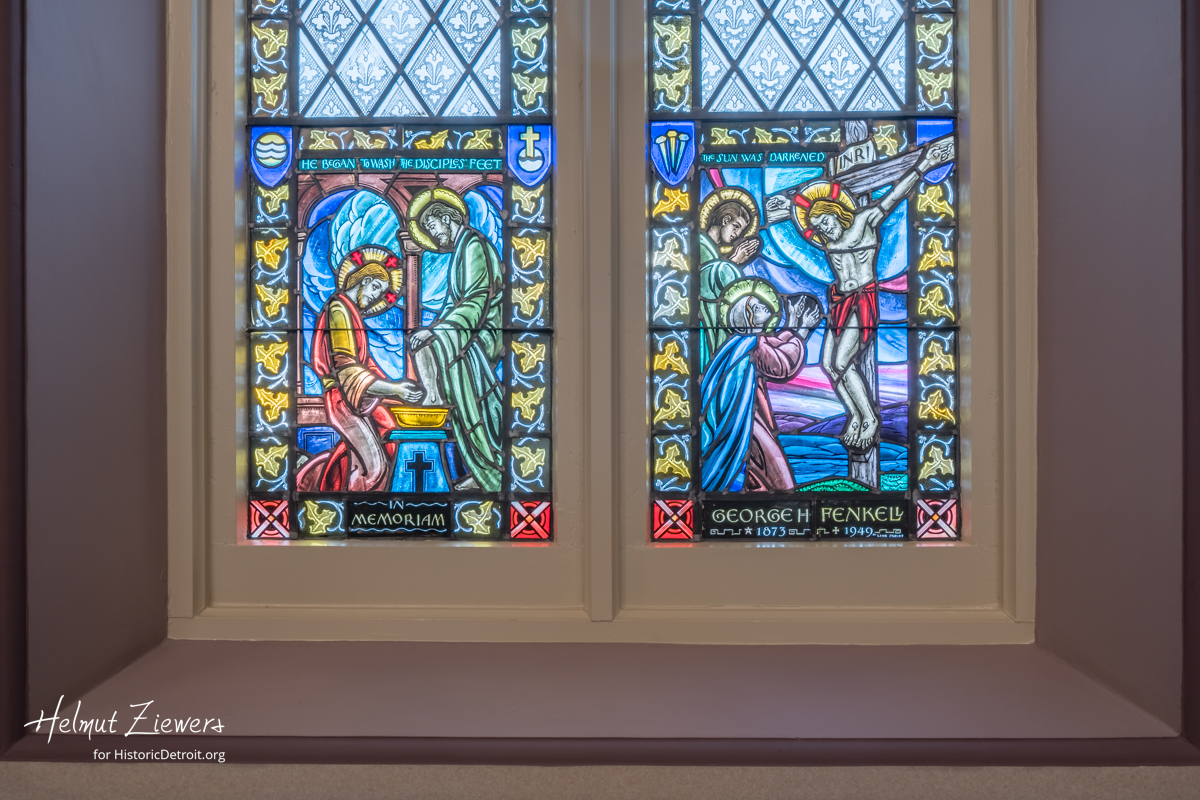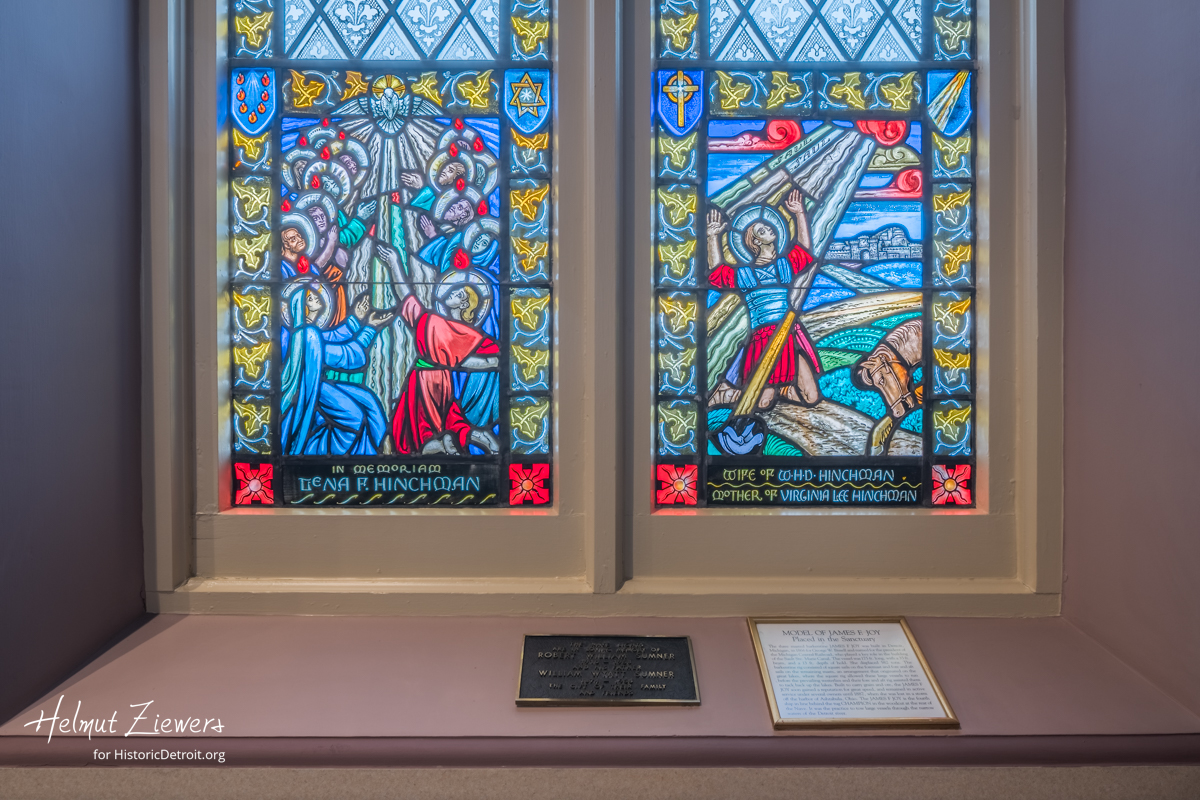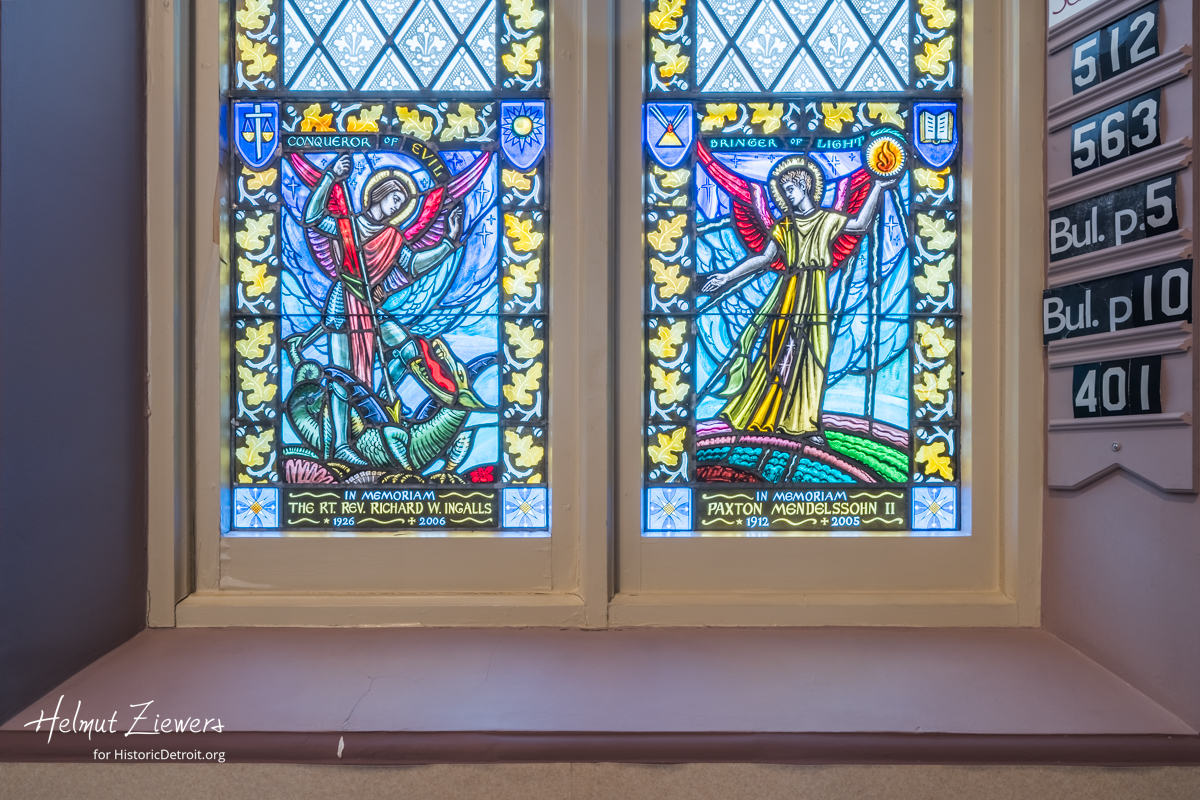Mariners Church - Photos Stained Glass
Mariners Church

The Ship of the Church in the center of the Western Rose Window (The Browning Compass Window). In the ship are seen the heads of the Twelve Apostles including Judas. The mast rises upward with the crossbar with the glow of the rising sun on the outspread sail.

The Western Rose Window (The Browning Compass Window) over the Organ and Choir Loft. This large window is in the shape of a Mariner's Compass and is centered with the "Ship of the Church". The compass has four main spokes which radiate vertically and horizontally. These spokes are emphasized by the symbols of the Gospels on which Christian doctrine is based. Reading from top to bottom and left to right:, they illustrate the winged man for Matthew (top) the winged lion for Mark, the winged ox for Luke and the winged eagle for John. The window was a memorial to Mrs. Bertie Ann Browning. The Brownings are known from their operation of the Bob-Lo boats and the Bob-Lo Island Amusement Park.

The Western Rose Window - The winged eagle for St. John.

The Western Rose Window - The winged ox for St. Luke.


The Altar Window - The window was created in the studios of J. and R. Lamb Company in Tenafly, NJ and a gift the William Rands family of the Rands Automotive Company, a firm which made windshields for the Ford Motor Company. They also donated the Bell Tower to the church.

The Altar Window - Picture taken from behind the altar.

The Altar Window - The majestic Central figure of Christ stilling the tempest and the Hand of God beckoning to the Voyageur are particularly appropriate for Mariners' Church.

The Altar Window - Surrounding the central figure are 22 figures of Mariners, either at sea, or in life's waters.

The Altar Window - The lighthouse which warns of storms on the Great Lakes, is on the upper right of the "Altar Window"

The Altar Window - The figures in the large window are most rewarding of detailed study. The 22 figures number early explorers of the Wilderness, Saxon Bishop and Saints, Evangelists, as well as early Detroiters. This window section (first row, upper left) shows Antoine Laumet de la Mothe, Cadillac (1658-1730), Sir Francis Drake (1540-1596), Rev. Richard Pollard (1752-1824) and Fr. Gabriel Richard (1767-1832)

The Altar Window - This section (first row, upper right) depicts John Monteith, the first president of the UoM, Columbus, the discoverer of America, Sir Walter Raleigh, one of the first colonizers of England's land across the sea, and Fr. Jacques Marquettes, one of the intrepid Jesuit explorers who bore the French flag and faith far into the American wilderness.

The Altar Window - The next section (second row, left) displays Saint Augustine (born 354 A.D.), Saint Ninian (born 360 A.D), Saint Cuthbert (born ca. 635 A.D.) and Julia Anderson (1793-1842) by the whose bequest the original Mariners' church was founded.

The Altar Window - This section (second row, right) displays Saint David (born ca 520 A.D.), Saint Patrick (born 389 A.D.), Saint Columba (born 521 A.D.) and Saint Brendan (born 577 A.D.)

The Altar Window - The next section (third row, left) displays St. Christopher (born ca 220 A.D.), St. Matthew (born in 1st century), and St. Mark (born 12 A.D.)

The Altar Window - The last section (third row, right) depicts St. Luke (born in 1st century), St John (born 11 A.D.) and St. Elmo, also known as St. Erasmus (born in 3rd century). Hiding his head, the devil cowers in the lower right corner - overcome by the presence of so many saints.

The Altar Window - Hiding his head, the devil cowers in the lower right corner - overcome by the presence of so many saints.

The Vernor Window - The Vernor window displays Saint Peter and Saint Andrew.

The Vernor Window - at the base of the window to the left is the Baptism of Christ in the Jordan. To the right is the first miracle during Christ's minitry - the turning of water into wine at the Marriage in Cana. James Vernor (1843-1927), the man memorialized in this window with his son, was a Detroit pharmacist who created and sold the drink called "Vernor's Ginger Ale."

The Tretheway Window - The Tretheway window depicts St. Philip and St. Bartholomew

The Tretheway Window - in the scenes at the bottom, the series of Christ's life continues. On the right is Christ preaching from the boat on Galilee, on the left is the miraculous haul of fishes.

The Fenkell Window - The Fenkell window displays Saint Thomas, the "practical" apostle and Saint James The Less, bishop of Jerusalem.

The Fenkell Window - George Harrison Fenkell came to Detroit in 1894 and bought a farm on a road which intersected Woodward Ave just five miles north of city hall. He became an engineer and was a municipal employee for many years, becoming head of the Detroit Department of Water Supply. His name was honored when Five Mile Road, which crossed Woodward Ave at the spot where his farm was located, was given the name of Fenkell Avenue.

The Ludington Window - the Ludington window displays St. Thaddeus and Saint Simon. The window commemorates a pioneer Michigan family involved with both, the lumbering and shipping interests in this Great Lakes state.

The Ludington Window - on the bottom right of the window is shown the Ascension and the Apostles who were present at that moment. The window commemorates a pioneer Michigan family involved with the lumbering and shipping interests in Michigan. Capt. Lewis Ludington (1858-1934) and Fandira Ludington (1859-1952)

The Hinchman Window - the Hinchman window depicts Saint James the Greater and Saint Paul.

The Hinchman Window - Mrs. Hinchman is remembered as the founder of the Woman's Exchange, a downtown outlet where craftswoman and needle workers could find a market for their handwork. On the right is the conversion of Paul in front of the walls of Damascus.

The Moreing Window - according to the book "The Windows of Old Mariners' " by Jean M. Fox, the nave windows on the left side were dedicated to different branches of the Armed Forces. This is the first window and is dedicated to the Navy. It depicts Old Testament figures associated with water - Noah and Moses.

The Moreing Window - a pastel artist, David Burr Moreing came to Detroit in 1914.

The Marine Corps Window - Patriarchs Abraham and Elijah are honored in this window.

The Marine Corps Window - also known as the Jeffries Window. The window commemorates three of the Jeffries family, Judge Edward Jeffries (1864-1939), Minnie Stott Jeffries (1867-1932) and Edward Jeffries Jr. (1900-1950)

The Army Window - the Army Window bears the figures of Joshua and David, two Old Testament warriors.

The Army Window - Hazen Pingree (1840-1901), Michigan's great reform governor is memorialized in this window. He was nominated mayor in 1889 and elected Michigan governor in 1896. Joshua at Jericho (left) and David and Goliath are displayed in the lower section of the window.

The Coast Guard Window - Angel Gabriel and Angel Raphael are depicted in the Coast Guard window over the door.

The Air Force Window - the Air Force window displays Archangel Michael, the Conqueror of Evil, and Uriel, the Bringer of Light.

The Air Force Window - The right base panel shows Uriel bringing the heavenly fire down to the fields of earth. The window commemorates Rt. Rev. Richard W. Ingalls (1926-2006) and Paxton Mendelssohn II (1912-2005)

The George Washington Stark Window in the Bell Tower

The George Washington Stark Window - Detail

Using three medallions, this window in the Bell Tower depicts developments in the powering of ships. The borders are formed with waves and propellers.